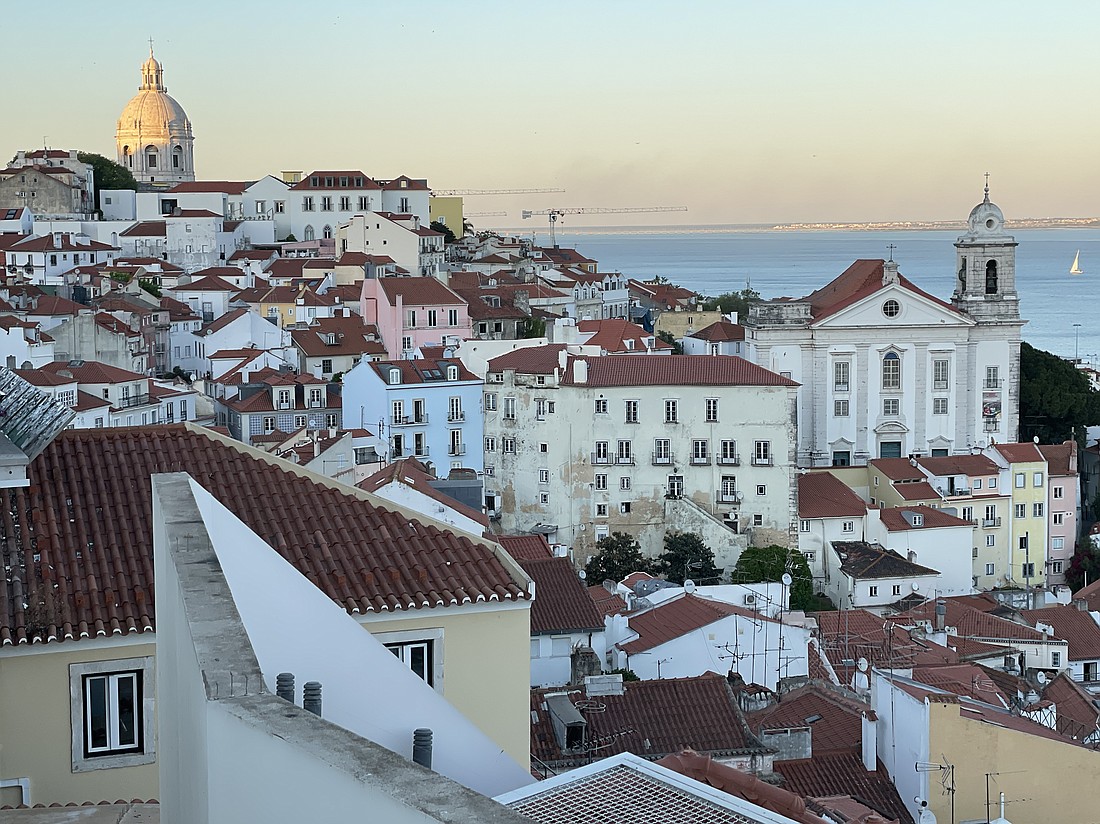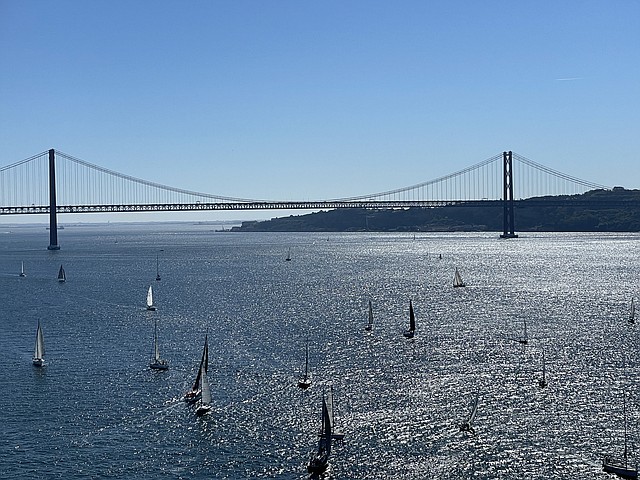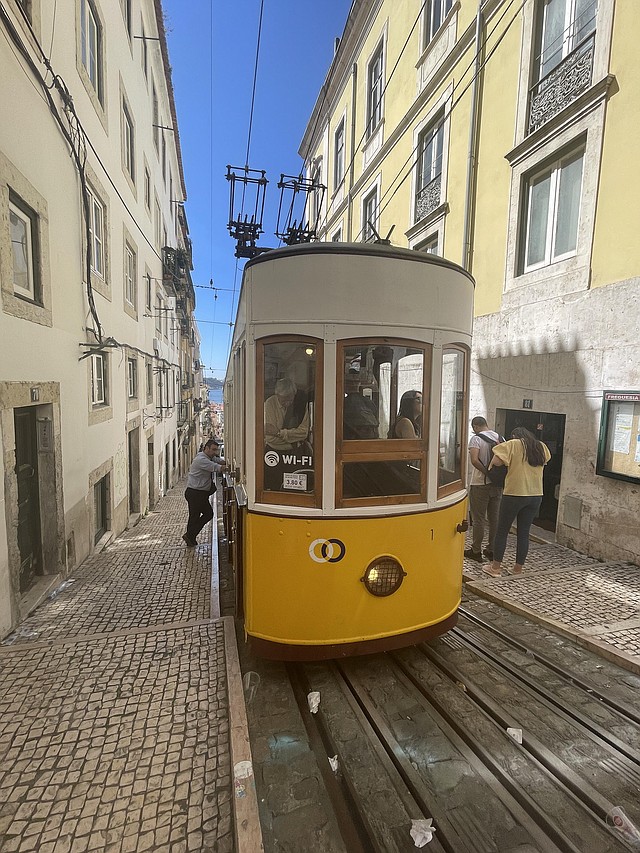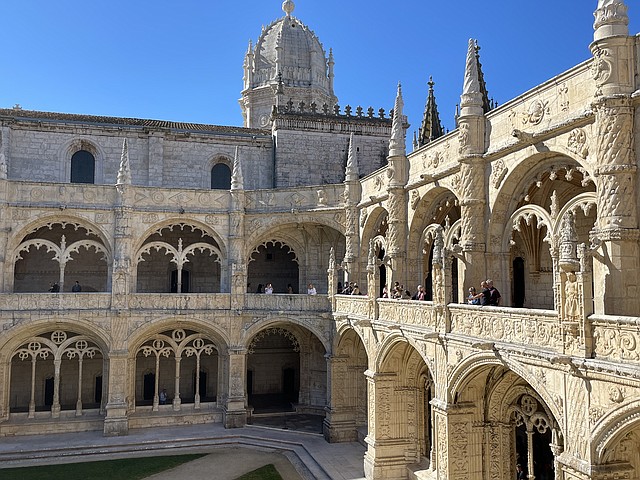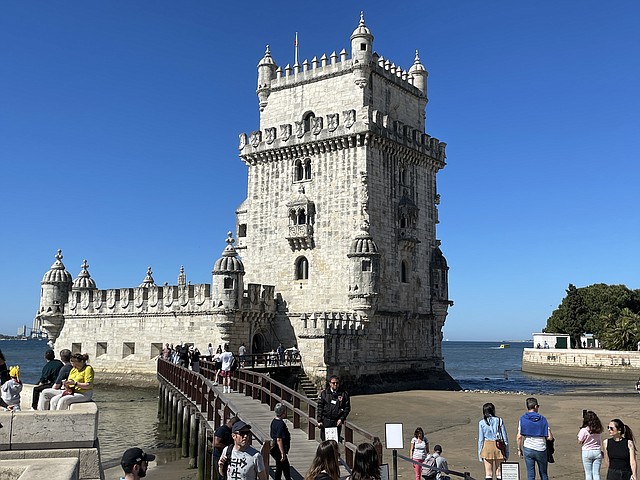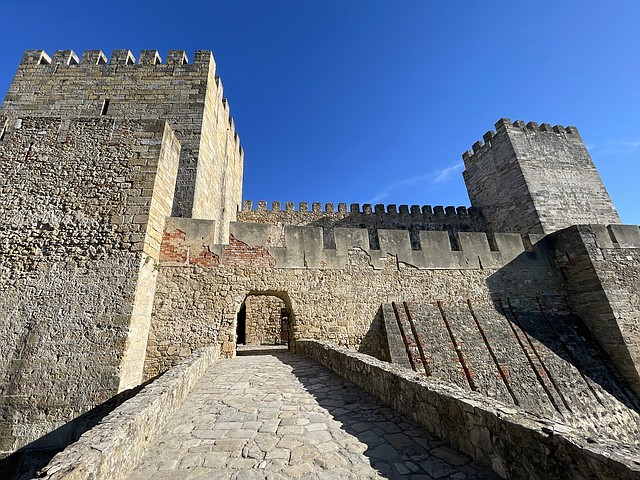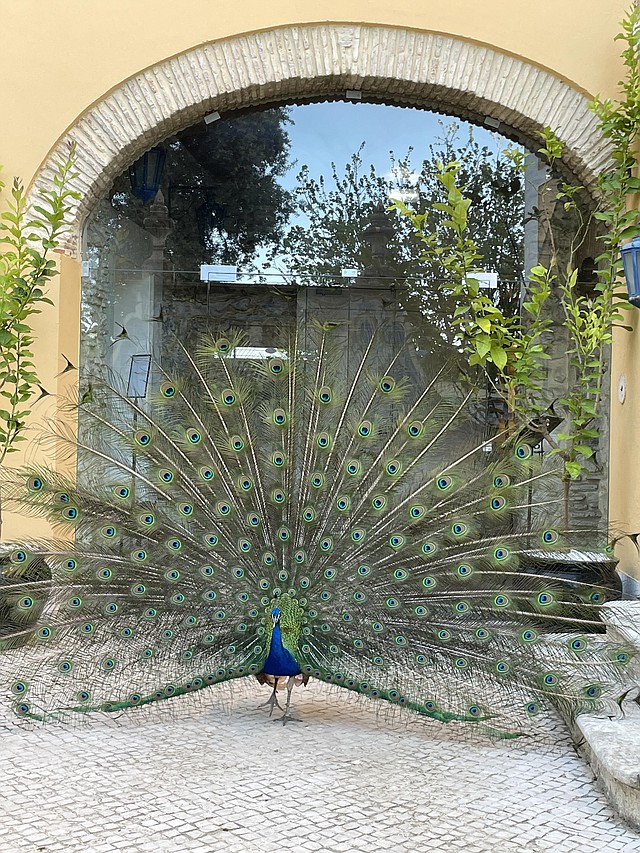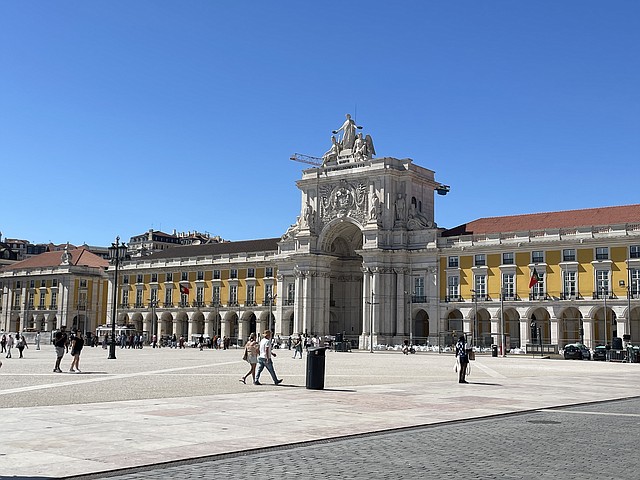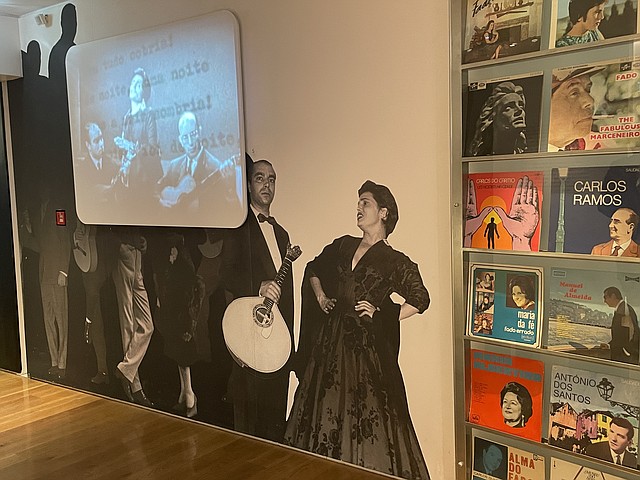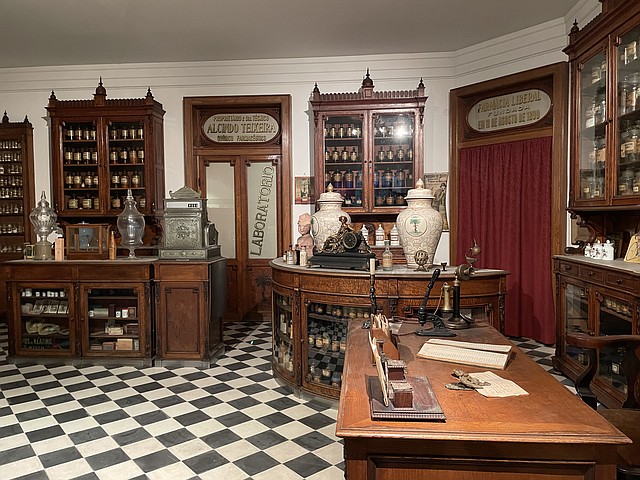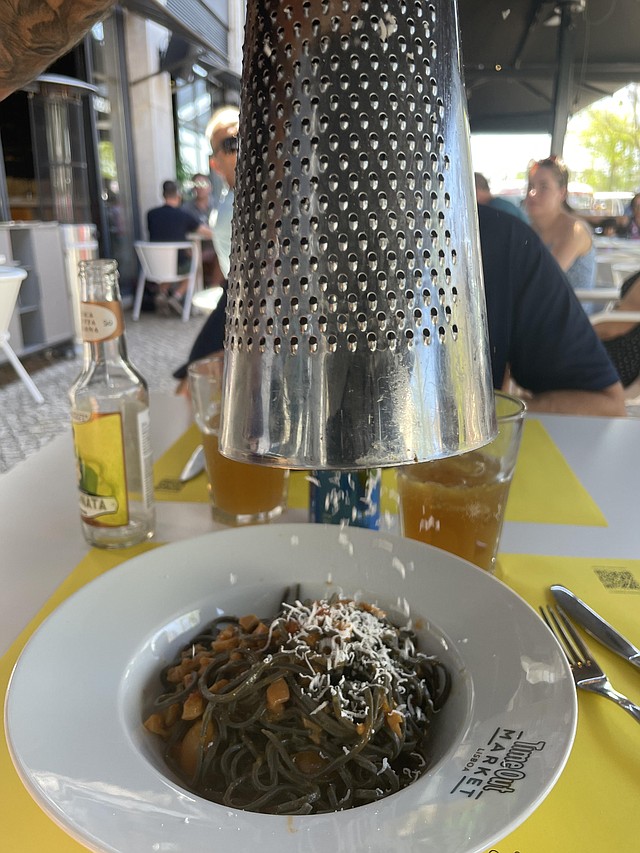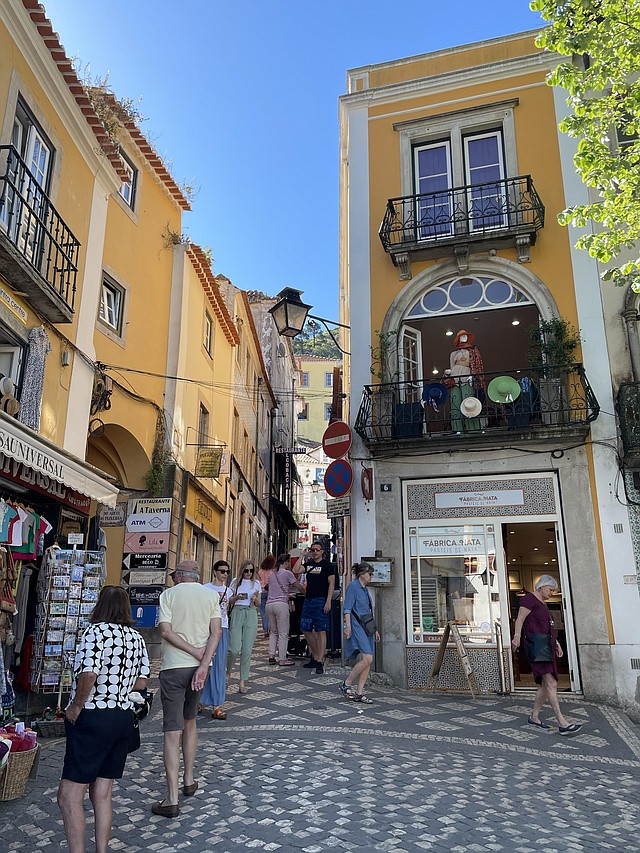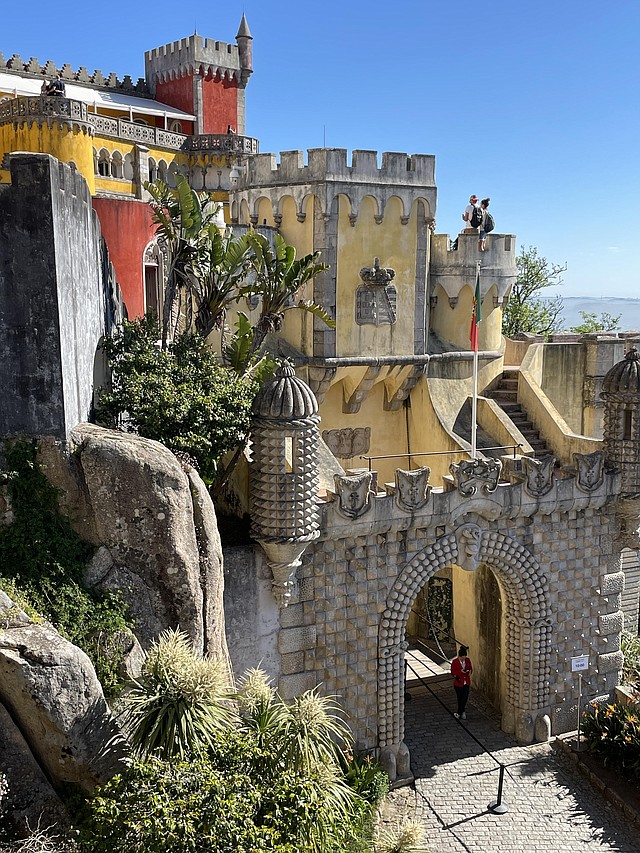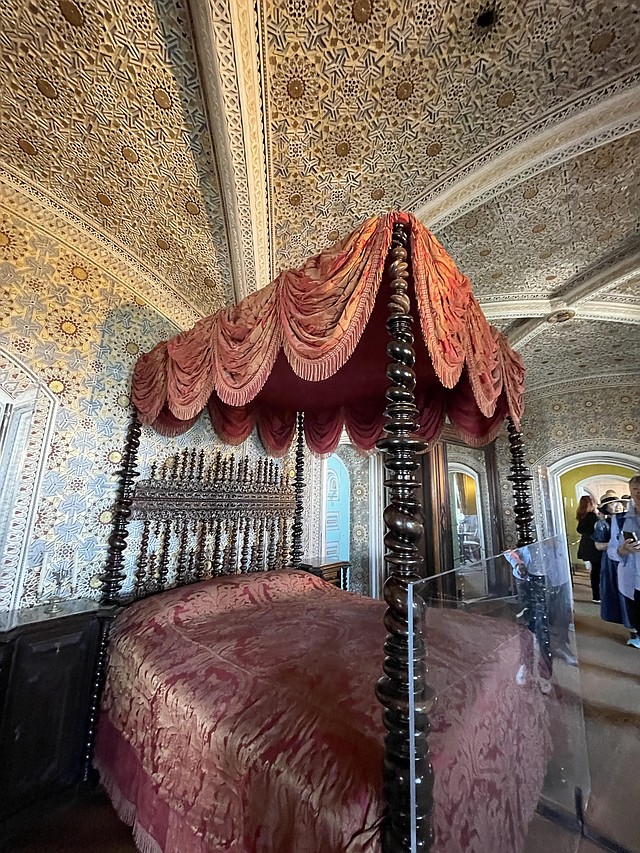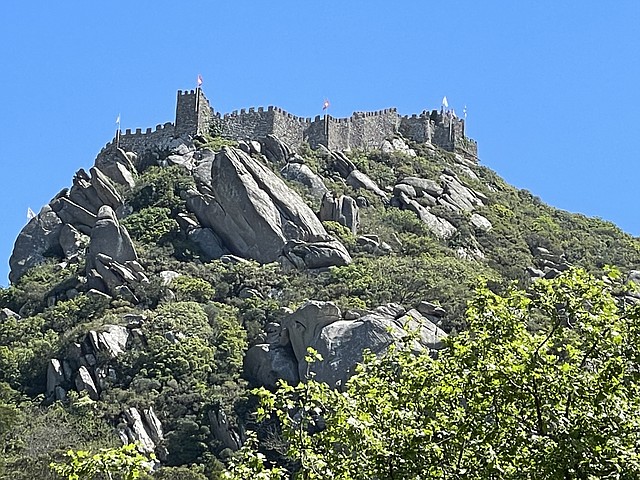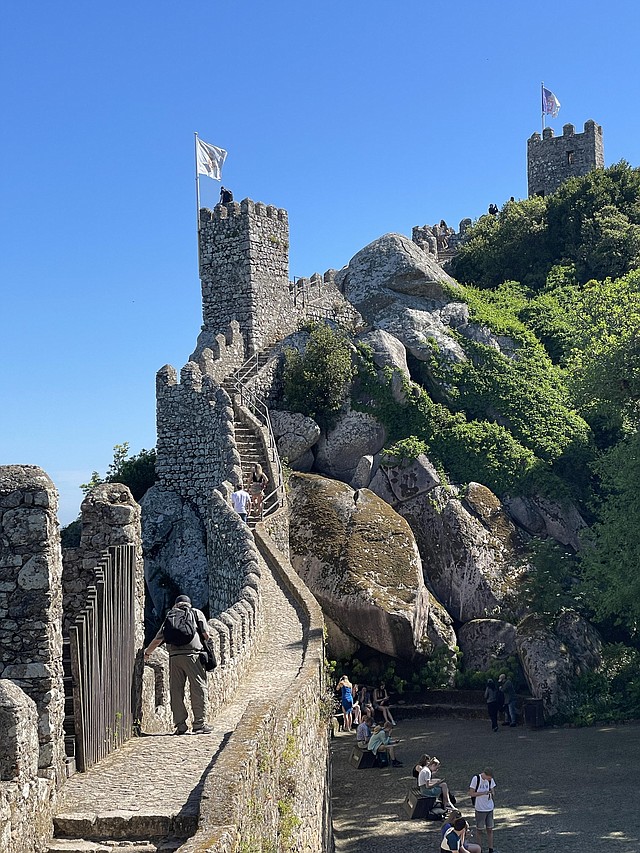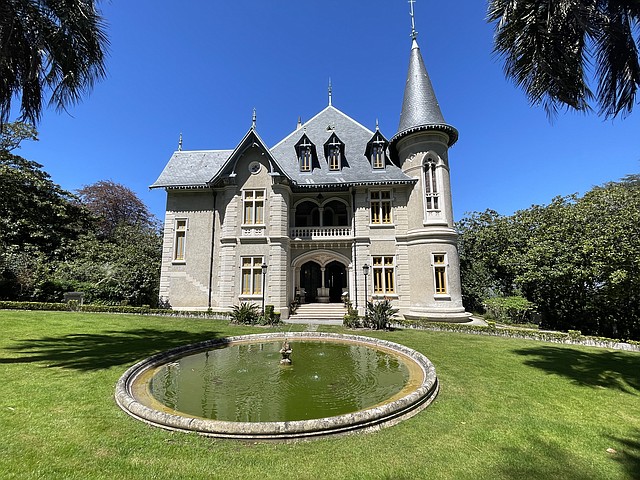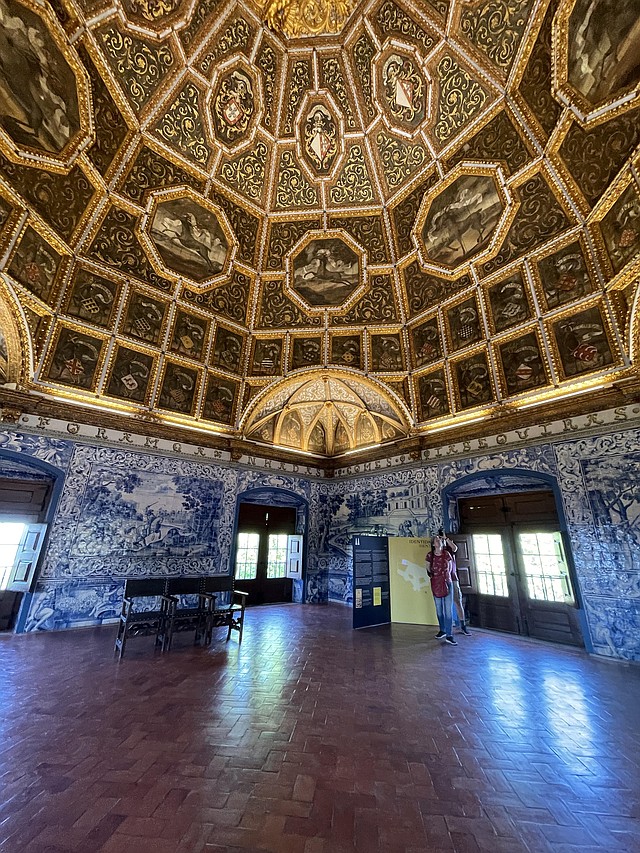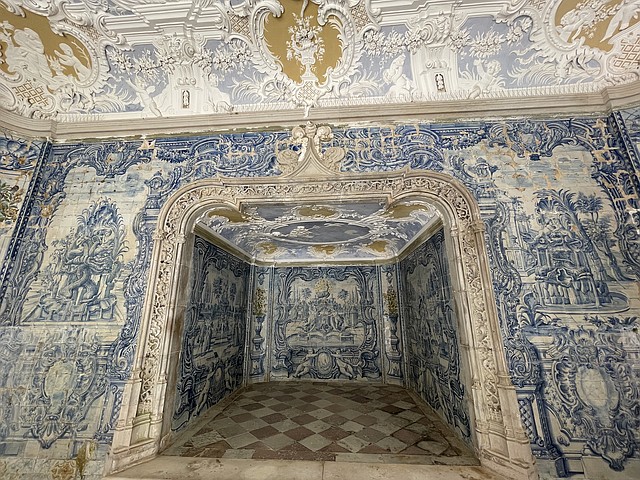Explore the exciting highlights of Lisbon and Sintra on a four-day self-guided tour
Travels with Deb
May 29, 2023 at 6:00 a.m.
...by DEBBIE STONE
There are so many ways to travel these days, and though I’ve tried and enjoyed many of them, I always come back to my favorite – self-guided, walking trips, where I get to make the decisions and can move at my own pace. These types of vacations often take a lot of planning and research, especially when going abroad. The planning is part of the fun, but I learned that having some assistance in this endeavor can be incredibly helpful, as well as a big timesaver.
Meet Inntravel. As champions of the Slow vacation, the company offers a tempting collection of 290 self-guided adventures amid the most scenic corners of Europe – both on and off the beaten track. Travelers can choose from trips on foot, on two wheels, on skis and snowshoes, or by rail, boat or car. Because of the comprehensive route notes and maps provided by the company, you have the freedom to explore at your own pace, discover little-known gems, and slip into the rhythms of local life.I booked Inntravel’s “Lisbon & the Palaces of Sintra 4-night self-guided walking trip” during my recent trip in Europe, and heartily appreciated the detailed information provided by the company to facilitate a memorable stay in these cities.
Lisbon is the capital and largest city of Portugal, and as such, is a vibrant, multi-faceted destination with no shortage of places to explore. With over twenty centuries of history, it’s known for its colorful past full of rulers, invasions, destructions and reconstructions. You’ll find a rich tapestry of cultures here and a wonderful meld of traditional heritage with forward-thinking innovation and modernism. Visitors are warmly welcomed in this sun-drenched, charming locale, where smiles are ever-present and obrigado, “thank you,” goes a long way.
The city has become very popular with travelers, which means that its top attractions can get crowded, especially during peak times. Make sure to get your tickets online ahead of time or better yet, purchase the Lisboa Card, which gives you free or reduced-price entrance fees to the city’s best sights plus unlimited travel on all forms of public transport, including the quirky funiculars which take you up and down the steepest of the city’s seven hills (do check out the iconic Bica Funicular!).
Several of Lisbon’s highlights are located in the Belém neighborhood. Here you’ll find the Jerónimos Monastery, a grand religious building dating back to the 16th century. This UNESCO World Heritage Site was historically associated with the early sailors, who set off to explore the world. At the time, sailors were very superstitious and would pray with the monks in the hope they would return safe and unharmed. It was here that legendary explorer Vasco da Gama spent his last night prior to his voyage to the Far East. His tomb lies within the church.The church is one of the most decorated in Portugal, with an ornately carved entrance, massive, vaulted ceilings and an ornamental altar. The incredible stone detail extends into the monastery with its unique two-level cloister.
Nearby is the Monument to the Discoveries, which sits next to the marina and overlooks the Tagus River, where ships departed to explore and trade with India and the Orient. It towers over 160 feet and offers panoramic views of the area from the rooftop. This larger-than-life stone edifice celebrates the achievements of explorers during the building of Portugal’s empire and was constructed in honor of Portugal’s Prince Henry the Navigator. Its shape resembles a ship’s prow and there are more than thirty statues of historical figures carved on it. In front of the monument is an enormous marble map of the world with significant dates in history.
Further down the waterfront is the Tower of Belém. Constructed in 1521 as a gateway to Lisbon, as well as a defense system, this national monument is impressive for its rich sculptural ornamentation and elaborate decorations influenced by Moorish art. To access the tower’s three floors and its terrace, visitors need to climb a narrow spiral staircase. At the top, you’ll be able to enjoy marvelous views once more.In the Belém district are also several museums of note: National Coach Museum, Berardo Collection Museum and the Maritime Museum. The National Coach Museum contains the most important collection of royal coaches in the world with 9,000 objects from the 16th to 19th centuries. Art afficionados will love the Berardo, a mecca for modern and contemporary art, with works from such notables as Picasso, Duchamp, Miró, Warhol and more. And those who want to delve into the history of Portugal’s “domination of the seas” will enjoy pursuing the Maritime Museum’s outstanding collection of 17,000 items and artifacts.
While you’re in Belém, stop in at Pastéis de Belém to try the famous Portuguese custard tarts. On an average weekday, 12,000 of these goodies are sold from this one location and a whopping 20,000 on the weekend. The shop has been making the tarts since 1837 and follows an ancient and secret recipe from the Jerónimos Monastery. Apparently, the monks used egg whites to starch their habits and the egg yolk to make custards. One bite of these flaky and creamy concoctions and you’ll be hooked! And just know that one tart will never be enough. Buy a box to take with you!
The historic heart of Lisbon is the Old Town. This area is comprised of a series of districts, each with their own unique allure. In the Alfama neighborhood, you’ll find Castle de São Jorge or St. George’s Castle, which sits atop the highest hill in the city. This celebrated landmark changed hands over the years, starting with the Romans, then later the Moors, until Portugal’s first king, Alfonso Henriques, captured it in 1147.Today, you can climb its many towers and walk along the ramparts for breathtaking vistas of the city. Within the walls is an archaeological dig site and artifacts found in the excavations are on display in the castle’s museum. A photo exhibit shows how the castle was “discovered” in the late 1930s, hidden within the walls of barracks.
Visiting the castle early when it first opens will ensure a more peaceful experience. With fewer people, you’ll share the grounds with a host of peacocks, geese and ducks. The peacocks pompously strut around, often in full regalia, letting you know they own this turf. In mating season or when in distress, they scream, pushing the shriek-o-meter to its loudest decibels. As to how they’ve ended up at the castle, story has it that they were originally brought to Lisbon as trophies during the 15th century Age of Discoveries. And they’ve been here ever since.As I had the pleasure of staying within the castle walls during my visit, at the delightful Hotel Solar do Castelo, I also saw these birds onsite and heard their vocalizations often. Eating breakfast on the patio, while the resident peacock pranced around was a special dining experience!
This boutique property is located in an inner courtyard of an 18th century mansion. Rooms are spacious and well-appointed with medieval-inspired furniture that is done with a contemporary twist. Many overlook the Moorish courtyard with its tiled décor and fountain. A full hot breakfast buffet is included in the pleasant lounge area. Downstairs is the hotel’s own mini museum with historic artifacts recovered from the site.
I loved strolling the narrow, winding streets in this area, gelato in hand. And it was easy to walk down to the center of Lisbon from here, with the resplendent Praca do Comércio, or Commerce Square, only about a half-mile away. This is a magnificent, harbor-facing plaza and one of the largest in Europe, distinguished by a gleaming, triumphal arch and flanked by stately yellow-hued, government office buildings. In the center is an equestrian statue of King José I.Here you’ll find the main tourist information center, along with cafes and restaurants. The Lisbon Story Center is also here and is a good place for those interested in tracing Lisbon’s key historical events via an interactive presentation. A filmed reenactment of the 1755 earthquake gives you an idea of the massive destruction it caused and the reconstruction that followed.
Two other museums made it on my list: the Fado Museum and Pharmacy Museum. Fado is the folk music of Lisbon’s “rustic” neighborhoods. It’s Portugal’s musical pride and is considered a national treasure. This form of music is characterized by mournful and melancholy ballads, often about lost sailors, the life of the poor and heartbreaks. The museum tells the story of fado from the 19th century to the present and includes the artistic journeys of dozens of fado stars, along with the evolution of the Portuguese guitar. An audio guide lets you hear these “Billie Holidays” of Portugal.
The Pharmacy Museum is lesser-known to tourists, despite it being award-winning. A self-guided tour of this interesting place takes you on a deep dive into the development of the pharmaceutical industry both in Portugal and worldwide, over 5,000 years. On display are rare artifacts, such as an ancient Egyptian sarcophagus, a 17th century hollow book with concealed areas in which hide poison, the pharmacist emergency kits used by Ernest Shackleton, as well as by the crew of Space Shuttle Endeavor. There are also re-creations of the interiors of different pharmacies, including a traditional Chinese one from Macau. And an entire section is devoted to the discoveries and scientific advances in the health arena.
When it comes to food, Lisbon has a wide variety of eateries, from tiny local cafes to trendy restaurants, showcasing Portuguese food from the regions. Prices are generally reasonable. Fish takes centerstage. Foremost is bacalhau or cod, which is prepared every way you can think of from grilled and boiled to deep fried, stewed and roasted. Tuna is also popular, along with oysters, shrimp and octopus. Meat is served grilled or baked, but it’s also found in the many stew dishes that you’ll see on the menu. And as in Spain, tapas or petiscos, as they are called in Portuguese, are ubiquitous.
Time Out Market is a good place to sample different kinds of dishes. Occupying a voluminous historical building near the water, this marketplace is a modern food hall with dozens of stalls and restaurants offering an extensive range of food, both savory and sweet, and liquid libations. The only problem is deciding what to eat or drink, and where, as the choices are overwhelming!
Leave the big city of Lisbon behind as you head to Sintra, once the summer retreat of kings and queens. To get to this enchanting town, hop on the train for a comfortable one-hour ride or opt for a forty-minute taxi trip. Though many people visit Sintra as a one-day excursion from Lisbon, spending a few nights here as I did allows you time to leisurely explore the top attractions. And when the daytrippers leave, you’ll be able to truly appreciate the town sans the crowds.
The entire city of Sintra is a UNESCO World Heritage site, which in itself is a magnet for tourists. But it’s the combination of unique historic properties amid stunning natural scenery that gives the place its magical allure.As with Lisbon, Inntravel provided me with detailed information about all things Sintra and booked a room for my two-night stay at the Sintra Boutique Hotel. Steps from the quaint old town center, the property is conveniently located to restaurants and shops. Rooms are clean, spacious and comfy, with views of the National Palace, the park or town. The staff is friendly and helpful, and a full breakfast is included to fuel you for the day’s activities.
There are several main attractions in Sintra that are on every visitor’s must-see list. As with Lisbon, I highly recommend booking your tickets online ahead of time to avoid the lines. And get started early.
Pena Palace is the crown jewel of Sintra and among one of the Seven Wonders of Portugal. Situated on a hilltop above town, amid a lush forest with exotic gardens, this Romanticist castle dates back to 1854 and is known for its colorful terraces, decorative battlements, onion-domed towers and statues of mythological creatures. Look for the sneering gargoyles!
From the outside, it appears like a Ronald McDonald House on steroids, with its vivid Crayola crayon hues and schizophrenic whirlwind of mismatching elements. Obviously, someone had quite the imagination and wanted people to be able to see the place from as far as Lisbon.
That someone was mad genius, King Ferdinand II of Portugal. He built the palace on the site of what was once a monastery, to serve as his summer residence. The architect was Baron Wilhelm Ludwig von Eschwege, though both Ferdinand and his wife Queen Maria II played a large role in the development of the project. They embraced extravagance and defied rational order in the design of this eclectically whimsical estate.After Ferdinand’s death, the palace was passed on to his second wife, who later sold it to King Luis. In 1889, the Portuguese State bought it and later classified it as a national monument, transforming it into a museum.
Inside, you’ll find the colors have been toned down in the staterooms, but it’s still over-the-top outlandish with a plethora of Oriental rugs, teak furniture and tromp-l’oeil murals, none of which matches. As you gaze at the murals on the walls and ceilings, you’d swear they’d been carved in wood, but in reality, they’ve been painted. A trick of the eye!Pena Park is a vast forested area, almost 500 acres in size, that surrounds the palace. It’s an attraction in itself, full of walking paths and hidden trails, pavilions, lakes, fern gardens and exotic trees, where you can stroll to your heart’s content, soaking up the Edenesque landscape.
High up on one of the peaks above Sintra is the imposing Moorish Castle. Originally built in the 8th century, the castle was positioned at such a vantage point as to ensure protection over the area. This bastion fought off many invasion attempts before succumbing to the Christian Crusade in 1147.Over the years, it was neglected and left to the forces of nature and decay. Later, though King Ferdinand II – yes, the same guy behind Pena Palace – ordered the reconstruction of the castle for its cultural merits.
Be prepared to climb the ancient walls and lookout towers to explore this massive and ominous- looking stronghold. Your efforts will be well-rewarded with picturesque panoramas in all directions.
Another popular castle is Quinta da Regaleira. The estate consists of a palace and chapel, as well as a park with lakes, grottoes, wells, towers and fountains. Owner Carvalho Monteiro, an eccentric millionaire, together with the assistance of Italian architect Luigi Manini, designed the property to encompass Monteiro’s passion for alchemy, Masonry and Rosicrucianism – a brotherhood claiming to have mysterious wisdom handed down from ancient times.
This fascinating place is akin to a fun house, full of hidden tunnels and secret passageways with concealed symbolism. The Initiation Wells are perhaps the most intriguing, in my opinion. They consist of a pair of wells that resemble underground towers lined with circular stairs. Supposedly, they were used for ceremonial purposes, never for water. The number of steps and spacing of the landings is said to be connected to Tarot mysticism.
Newly opened to the public for the first time in 2022, Biester Palace and Park was built in 1880 for wealthy merchant Ernesto Biester. This elegant residence features conical roofs, frescos, exquisitely painted ceilings, neo-Gothic windows and a handsomely carved main staircase. The house has its own chapel, music room, ballroom and library.After touring the palace, head into the park, with its exotic flora, waterfalls, lake, cave and greenhouse. Stop in at the teahouse for a drink or snack and luxuriate in the serene environment.
Sintra National Palace is also worthy of a visit. The palace was the principal residence of the Moorish rulers up until their defeat in the 12th century. It was then passed on to the Portuguese king, Afonso Henriques. Today, much of what can be seen is from the 15th century, however, there are few furnishings of the period remaining, so many of the rooms are primarily empty.You might be confused as to the different styles of architecture. The reason for so many styles is because numerous rooms were added during a stretch of centuries under various rulers. Of note are the handsome entrance arches and main façade of the building, conical chimneys, ceramic tiles, carved ceilings and fountains. The rooms of particular interest to me were the Swan’s Room with its ceiling of painted swans; Pegas’ Room and its decorative magpies; Coats-of-Arms Room with its heraldic symbols; and Arab Room featuring intricate Moorish designs, colorful tiles and ornate fountain.
Don’t leave before checking out the Grotto of the Baths. This underground cave is covered in magnificent tile panels and stucco decoration. It’s believed to have been used as a royal bathhouse by the Portuguese monarchy.If you go:
www.inntravel.co.uk
Lisbon & the Palaces of Sintra 4-night self-guided walking trip:
https://www.inntravel.co.uk/walking-holidays/portugal/lisbon-palaces-of-sintra
Palaces & Pathways of Sintra 7-night, self-guided walking trip:
https://www.inntravel.co.uk/walking-holidays/portugal/pathways-palaces-sintra
Debbie Stone is an established travel writer and columnist, who crosses the globe in search of unique destinations and experiences to share with her readers and listeners. She’s an avid explorer who welcomes new opportunities to increase awareness and enthusiasm for places, culture, food, history, nature, outdoor adventure, wellness and more. Her travels have taken her to nearly 100 countries spanning all seven continents, and her stories appear in numerous print and digital publications.
Meet Inntravel. As champions of the Slow vacation, the company offers a tempting collection of 290 self-guided adventures amid the most scenic corners of Europe – both on and off the beaten track. Travelers can choose from trips on foot, on two wheels, on skis and snowshoes, or by rail, boat or car. Because of the comprehensive route notes and maps provided by the company, you have the freedom to explore at your own pace, discover little-known gems, and slip into the rhythms of local life.I booked Inntravel’s “Lisbon & the Palaces of Sintra 4-night self-guided walking trip” during my recent trip in Europe, and heartily appreciated the detailed information provided by the company to facilitate a memorable stay in these cities.
Lisbon is the capital and largest city of Portugal, and as such, is a vibrant, multi-faceted destination with no shortage of places to explore. With over twenty centuries of history, it’s known for its colorful past full of rulers, invasions, destructions and reconstructions. You’ll find a rich tapestry of cultures here and a wonderful meld of traditional heritage with forward-thinking innovation and modernism. Visitors are warmly welcomed in this sun-drenched, charming locale, where smiles are ever-present and obrigado, “thank you,” goes a long way.
The city has become very popular with travelers, which means that its top attractions can get crowded, especially during peak times. Make sure to get your tickets online ahead of time or better yet, purchase the Lisboa Card, which gives you free or reduced-price entrance fees to the city’s best sights plus unlimited travel on all forms of public transport, including the quirky funiculars which take you up and down the steepest of the city’s seven hills (do check out the iconic Bica Funicular!).
Several of Lisbon’s highlights are located in the Belém neighborhood. Here you’ll find the Jerónimos Monastery, a grand religious building dating back to the 16th century. This UNESCO World Heritage Site was historically associated with the early sailors, who set off to explore the world. At the time, sailors were very superstitious and would pray with the monks in the hope they would return safe and unharmed. It was here that legendary explorer Vasco da Gama spent his last night prior to his voyage to the Far East. His tomb lies within the church.The church is one of the most decorated in Portugal, with an ornately carved entrance, massive, vaulted ceilings and an ornamental altar. The incredible stone detail extends into the monastery with its unique two-level cloister.
Nearby is the Monument to the Discoveries, which sits next to the marina and overlooks the Tagus River, where ships departed to explore and trade with India and the Orient. It towers over 160 feet and offers panoramic views of the area from the rooftop. This larger-than-life stone edifice celebrates the achievements of explorers during the building of Portugal’s empire and was constructed in honor of Portugal’s Prince Henry the Navigator. Its shape resembles a ship’s prow and there are more than thirty statues of historical figures carved on it. In front of the monument is an enormous marble map of the world with significant dates in history.
Further down the waterfront is the Tower of Belém. Constructed in 1521 as a gateway to Lisbon, as well as a defense system, this national monument is impressive for its rich sculptural ornamentation and elaborate decorations influenced by Moorish art. To access the tower’s three floors and its terrace, visitors need to climb a narrow spiral staircase. At the top, you’ll be able to enjoy marvelous views once more.In the Belém district are also several museums of note: National Coach Museum, Berardo Collection Museum and the Maritime Museum. The National Coach Museum contains the most important collection of royal coaches in the world with 9,000 objects from the 16th to 19th centuries. Art afficionados will love the Berardo, a mecca for modern and contemporary art, with works from such notables as Picasso, Duchamp, Miró, Warhol and more. And those who want to delve into the history of Portugal’s “domination of the seas” will enjoy pursuing the Maritime Museum’s outstanding collection of 17,000 items and artifacts.
While you’re in Belém, stop in at Pastéis de Belém to try the famous Portuguese custard tarts. On an average weekday, 12,000 of these goodies are sold from this one location and a whopping 20,000 on the weekend. The shop has been making the tarts since 1837 and follows an ancient and secret recipe from the Jerónimos Monastery. Apparently, the monks used egg whites to starch their habits and the egg yolk to make custards. One bite of these flaky and creamy concoctions and you’ll be hooked! And just know that one tart will never be enough. Buy a box to take with you!
The historic heart of Lisbon is the Old Town. This area is comprised of a series of districts, each with their own unique allure. In the Alfama neighborhood, you’ll find Castle de São Jorge or St. George’s Castle, which sits atop the highest hill in the city. This celebrated landmark changed hands over the years, starting with the Romans, then later the Moors, until Portugal’s first king, Alfonso Henriques, captured it in 1147.Today, you can climb its many towers and walk along the ramparts for breathtaking vistas of the city. Within the walls is an archaeological dig site and artifacts found in the excavations are on display in the castle’s museum. A photo exhibit shows how the castle was “discovered” in the late 1930s, hidden within the walls of barracks.
Visiting the castle early when it first opens will ensure a more peaceful experience. With fewer people, you’ll share the grounds with a host of peacocks, geese and ducks. The peacocks pompously strut around, often in full regalia, letting you know they own this turf. In mating season or when in distress, they scream, pushing the shriek-o-meter to its loudest decibels. As to how they’ve ended up at the castle, story has it that they were originally brought to Lisbon as trophies during the 15th century Age of Discoveries. And they’ve been here ever since.As I had the pleasure of staying within the castle walls during my visit, at the delightful Hotel Solar do Castelo, I also saw these birds onsite and heard their vocalizations often. Eating breakfast on the patio, while the resident peacock pranced around was a special dining experience!
This boutique property is located in an inner courtyard of an 18th century mansion. Rooms are spacious and well-appointed with medieval-inspired furniture that is done with a contemporary twist. Many overlook the Moorish courtyard with its tiled décor and fountain. A full hot breakfast buffet is included in the pleasant lounge area. Downstairs is the hotel’s own mini museum with historic artifacts recovered from the site.
I loved strolling the narrow, winding streets in this area, gelato in hand. And it was easy to walk down to the center of Lisbon from here, with the resplendent Praca do Comércio, or Commerce Square, only about a half-mile away. This is a magnificent, harbor-facing plaza and one of the largest in Europe, distinguished by a gleaming, triumphal arch and flanked by stately yellow-hued, government office buildings. In the center is an equestrian statue of King José I.Here you’ll find the main tourist information center, along with cafes and restaurants. The Lisbon Story Center is also here and is a good place for those interested in tracing Lisbon’s key historical events via an interactive presentation. A filmed reenactment of the 1755 earthquake gives you an idea of the massive destruction it caused and the reconstruction that followed.
Two other museums made it on my list: the Fado Museum and Pharmacy Museum. Fado is the folk music of Lisbon’s “rustic” neighborhoods. It’s Portugal’s musical pride and is considered a national treasure. This form of music is characterized by mournful and melancholy ballads, often about lost sailors, the life of the poor and heartbreaks. The museum tells the story of fado from the 19th century to the present and includes the artistic journeys of dozens of fado stars, along with the evolution of the Portuguese guitar. An audio guide lets you hear these “Billie Holidays” of Portugal.
The Pharmacy Museum is lesser-known to tourists, despite it being award-winning. A self-guided tour of this interesting place takes you on a deep dive into the development of the pharmaceutical industry both in Portugal and worldwide, over 5,000 years. On display are rare artifacts, such as an ancient Egyptian sarcophagus, a 17th century hollow book with concealed areas in which hide poison, the pharmacist emergency kits used by Ernest Shackleton, as well as by the crew of Space Shuttle Endeavor. There are also re-creations of the interiors of different pharmacies, including a traditional Chinese one from Macau. And an entire section is devoted to the discoveries and scientific advances in the health arena.
When it comes to food, Lisbon has a wide variety of eateries, from tiny local cafes to trendy restaurants, showcasing Portuguese food from the regions. Prices are generally reasonable. Fish takes centerstage. Foremost is bacalhau or cod, which is prepared every way you can think of from grilled and boiled to deep fried, stewed and roasted. Tuna is also popular, along with oysters, shrimp and octopus. Meat is served grilled or baked, but it’s also found in the many stew dishes that you’ll see on the menu. And as in Spain, tapas or petiscos, as they are called in Portuguese, are ubiquitous.
Time Out Market is a good place to sample different kinds of dishes. Occupying a voluminous historical building near the water, this marketplace is a modern food hall with dozens of stalls and restaurants offering an extensive range of food, both savory and sweet, and liquid libations. The only problem is deciding what to eat or drink, and where, as the choices are overwhelming!
Leave the big city of Lisbon behind as you head to Sintra, once the summer retreat of kings and queens. To get to this enchanting town, hop on the train for a comfortable one-hour ride or opt for a forty-minute taxi trip. Though many people visit Sintra as a one-day excursion from Lisbon, spending a few nights here as I did allows you time to leisurely explore the top attractions. And when the daytrippers leave, you’ll be able to truly appreciate the town sans the crowds.
The entire city of Sintra is a UNESCO World Heritage site, which in itself is a magnet for tourists. But it’s the combination of unique historic properties amid stunning natural scenery that gives the place its magical allure.As with Lisbon, Inntravel provided me with detailed information about all things Sintra and booked a room for my two-night stay at the Sintra Boutique Hotel. Steps from the quaint old town center, the property is conveniently located to restaurants and shops. Rooms are clean, spacious and comfy, with views of the National Palace, the park or town. The staff is friendly and helpful, and a full breakfast is included to fuel you for the day’s activities.
There are several main attractions in Sintra that are on every visitor’s must-see list. As with Lisbon, I highly recommend booking your tickets online ahead of time to avoid the lines. And get started early.
Pena Palace is the crown jewel of Sintra and among one of the Seven Wonders of Portugal. Situated on a hilltop above town, amid a lush forest with exotic gardens, this Romanticist castle dates back to 1854 and is known for its colorful terraces, decorative battlements, onion-domed towers and statues of mythological creatures. Look for the sneering gargoyles!
From the outside, it appears like a Ronald McDonald House on steroids, with its vivid Crayola crayon hues and schizophrenic whirlwind of mismatching elements. Obviously, someone had quite the imagination and wanted people to be able to see the place from as far as Lisbon.
That someone was mad genius, King Ferdinand II of Portugal. He built the palace on the site of what was once a monastery, to serve as his summer residence. The architect was Baron Wilhelm Ludwig von Eschwege, though both Ferdinand and his wife Queen Maria II played a large role in the development of the project. They embraced extravagance and defied rational order in the design of this eclectically whimsical estate.After Ferdinand’s death, the palace was passed on to his second wife, who later sold it to King Luis. In 1889, the Portuguese State bought it and later classified it as a national monument, transforming it into a museum.
Inside, you’ll find the colors have been toned down in the staterooms, but it’s still over-the-top outlandish with a plethora of Oriental rugs, teak furniture and tromp-l’oeil murals, none of which matches. As you gaze at the murals on the walls and ceilings, you’d swear they’d been carved in wood, but in reality, they’ve been painted. A trick of the eye!Pena Park is a vast forested area, almost 500 acres in size, that surrounds the palace. It’s an attraction in itself, full of walking paths and hidden trails, pavilions, lakes, fern gardens and exotic trees, where you can stroll to your heart’s content, soaking up the Edenesque landscape.
High up on one of the peaks above Sintra is the imposing Moorish Castle. Originally built in the 8th century, the castle was positioned at such a vantage point as to ensure protection over the area. This bastion fought off many invasion attempts before succumbing to the Christian Crusade in 1147.Over the years, it was neglected and left to the forces of nature and decay. Later, though King Ferdinand II – yes, the same guy behind Pena Palace – ordered the reconstruction of the castle for its cultural merits.
Be prepared to climb the ancient walls and lookout towers to explore this massive and ominous- looking stronghold. Your efforts will be well-rewarded with picturesque panoramas in all directions.
Another popular castle is Quinta da Regaleira. The estate consists of a palace and chapel, as well as a park with lakes, grottoes, wells, towers and fountains. Owner Carvalho Monteiro, an eccentric millionaire, together with the assistance of Italian architect Luigi Manini, designed the property to encompass Monteiro’s passion for alchemy, Masonry and Rosicrucianism – a brotherhood claiming to have mysterious wisdom handed down from ancient times.
This fascinating place is akin to a fun house, full of hidden tunnels and secret passageways with concealed symbolism. The Initiation Wells are perhaps the most intriguing, in my opinion. They consist of a pair of wells that resemble underground towers lined with circular stairs. Supposedly, they were used for ceremonial purposes, never for water. The number of steps and spacing of the landings is said to be connected to Tarot mysticism.
Newly opened to the public for the first time in 2022, Biester Palace and Park was built in 1880 for wealthy merchant Ernesto Biester. This elegant residence features conical roofs, frescos, exquisitely painted ceilings, neo-Gothic windows and a handsomely carved main staircase. The house has its own chapel, music room, ballroom and library.After touring the palace, head into the park, with its exotic flora, waterfalls, lake, cave and greenhouse. Stop in at the teahouse for a drink or snack and luxuriate in the serene environment.
Sintra National Palace is also worthy of a visit. The palace was the principal residence of the Moorish rulers up until their defeat in the 12th century. It was then passed on to the Portuguese king, Afonso Henriques. Today, much of what can be seen is from the 15th century, however, there are few furnishings of the period remaining, so many of the rooms are primarily empty.You might be confused as to the different styles of architecture. The reason for so many styles is because numerous rooms were added during a stretch of centuries under various rulers. Of note are the handsome entrance arches and main façade of the building, conical chimneys, ceramic tiles, carved ceilings and fountains. The rooms of particular interest to me were the Swan’s Room with its ceiling of painted swans; Pegas’ Room and its decorative magpies; Coats-of-Arms Room with its heraldic symbols; and Arab Room featuring intricate Moorish designs, colorful tiles and ornate fountain.
Don’t leave before checking out the Grotto of the Baths. This underground cave is covered in magnificent tile panels and stucco decoration. It’s believed to have been used as a royal bathhouse by the Portuguese monarchy.If you go:
www.inntravel.co.uk
Lisbon & the Palaces of Sintra 4-night self-guided walking trip:
https://www.inntravel.co.uk/walking-holidays/portugal/lisbon-palaces-of-sintra
Palaces & Pathways of Sintra 7-night, self-guided walking trip:
https://www.inntravel.co.uk/walking-holidays/portugal/pathways-palaces-sintra
Debbie Stone is an established travel writer and columnist, who crosses the globe in search of unique destinations and experiences to share with her readers and listeners. She’s an avid explorer who welcomes new opportunities to increase awareness and enthusiasm for places, culture, food, history, nature, outdoor adventure, wellness and more. Her travels have taken her to nearly 100 countries spanning all seven continents, and her stories appear in numerous print and digital publications.
